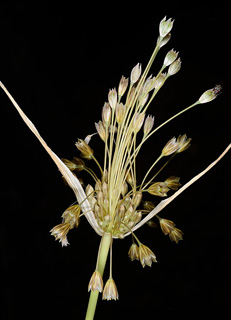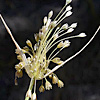Allium therinanthum – a species new to science – was recently described in the journal Phytotaxa, following its discovery two years ago by Sicilian botanists and myself.
Prof. Salvatore Brullo and Dr. Gianpietro Giusso del Galdo are world experts in wild garlics. It was during a visit to Israel and a tour of Mt Hermon with me in June 2012 that the a yet un-identified population of garlics was found.
Several samples were collected and grown at the Jerusalem Botanical Gardens in Givat Ram and at Prof. Brullo's laboratory in Sicily. They were compared with related and known species and their chromosomes were charted. The conclusion: This was a plant unknown to science.
The plant's scientific name, Allium therinanthum, means summer-blooming garlic. Its Hebrew name is Shum keitzi (summer garlic). During further trips to Mt. Hermon, I found the plant in several sites at heights of 1,450-1,700 m. The plant grows in open, mountainous steppe forest, in the semi-shade of oak trees.
This species has been declared endangered as it has only been found in a small area so far. Its status will change if – as is possible – it is found elsewhere in Israel, Syria or Lebanon. On the Israeli side of Mount Hermon, it is at risk of being trodden down by grazing cows, a new threat to many plants on the mountain.
Allium therinanthum blooms in summer after its leaves have dried up. Its flowers are straw colored, which helps it to hide from animals seeking fresh vegetation to eat. Why does a plant bloom in summer when the soil is dry and evaporation of water high? Evidently, the summer-blooming garlics avoid spring's competition for pollinating insects and take advantage of the summer when those insects that are around will visit them, because little else is flowering.
Israel has 46 species of wild garlic, only a few of which are related to the garden garlic and onion which we use in cooking. The genus Allium was once thought to belong to the Liliaceae family, and then to the Alliaceae family, but new research shows that it belongs to the Amaryllidaceae (daffodil) family. Allium therinanthum is related to other local species: A. tardiflorum, A. galilaeum, and A. daninii.
It differs from them in :
1. A plant of the open deciduous mountain forest of Mt Hermon, not below 1400 m. Blooms in June-July (A. tardiflorum blooms in autumn in Mt Carmel).
2. Spathe divided to 2-3 erect lobes (reflexed in A. galilaeum).
3. Anthers are not exerted (much exserted in A. hermoneum and A. daninii).
4. Bulb 2-3 cm across (smaller, around 2 cm across in A. galilaeum and even smaller in A. daninii).
5. Leaves 4 (5-6 in A. galilaeum).
6. There are no interstaminal teeth (tiny ones in A. galilaeum).
Original article: Phytotaxa (Vol. 164, No. 12 April 2014).
Translation - Susan Hatis-Rolef




